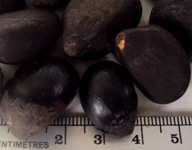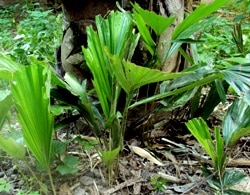Kaong propagation requires the use of seeds. Wildlings can also be collected from forest floor or under the canopy of mature plants.
These methods, including pregermination treatments before seeding, have been widely used in many palm species such as anahaw (Livistona rotundifolia), buri (Corypha elata), Macarthur palm (Ptychosperma macarthurii), royal palm (Roystonea regia), yellow palm (Chrysalidocarpus lutescens) and rattans.
This is so because these plants and kaong (Arenga pinnata), also called gomuti and sweet palm, belong to the same botanical family Palmae or Arecaceae. These palm plants share common characteristics which affect plant propagation.
The seeds are recalcitrant, meaning that they are sensitive to drying and cool storage. Recalcitrant seeds are readily killed by drying, most especially if their moisture content falls below the critical level of 12-30%. They generally cannot tolerate temperatures lower than 20%. Due to high moisture content, they cannot be stored for long because they are prone to rotting caused by microbial growth. Therefore, the seeds must be planted immediately.
Another constraint in kaong propagation by seed is the long duration of germination. As reported, untreated seeds which are naturally dispersed show 10-20% germination after 6 months. This is common in wild plant species and in palms having seeds with thick seed coat and hilum cover.
The hilum is that brownish protrusion which makes one end of the kaong seed pointed in shape. It is the point of attachment of the seed to the mother plant and is equivalent to the umbellical cord in humans. The new shoot and roots emerge from this part of the seed.

To promote rapid germination of kaong seeds, the following pregermination treatments have been recommended:
1. Scarification. Seeds should be scratched near the germination spot (hilum) until the brown, inner seed-coat layer becomes visible, then soaked in water overnight and, as alternative,
2. Warm Water Treatment. The seeds are soaked in water of about 30 deg. C for 24 hours.
Within 2-3 weeks after seeding, about 80% of the seeds will have germinated and transplanted to any potting container (ICRAF n.d.).
For practical application to kaong propagation, scarification of seeds can be done by rubbing the seed in any abrasive material like sand paper and sharpening stone. Extreme care should be observed to prevent injury to the “eye” or embryo.
Florido and De Mesa (2003) also recommends the following pretreatment in propagating kaong using seeds: “Remove the hilar (hilum) cover using sharp pointed knife. Soak the pretreated seeds in tap water until the radicle emerges in the hilar area. Change the water daily to prevent bacterial contamination.”

As alternative or supplement to kaong propagation by seeds, wildlings can be used as planting materials. Wildlings are seedlings which naturally grow below the canopy of plants from fallen seeds or anywhere on the ground where the seeds are dispersed by animals. Wildlings should be uprooted with the use of bolo or spade or any suitable tool, taking care to minimize injury to the roots. The seedlings are then inserted in a plastic bag, moistened and the opening of the bag is tied securely to prevent escape of moisture.
The wildlings are protected against direct sunlight in transporting them to the nursery. As a general rule, potting should be done immediately.
The potted wildlings should be allowed to regenerate new roots under shade and humid condition. Regular monitoring is necessary to prevent drying of the potting medium.
References
International Center for Research in Agroforestry (ICRAF). n.d. Species information: Arenga pinnata. Retrieved August 26, 2010 from http://erdb.denr.gov.ph/publications/rise/r_v15n2.pdf.
FLORIDO HB, DE MESA PB. 2003. Sugar palm (Arenga pinnata (Wurmb.) Merr. Research Information Series on Ecosystem (RISE). Vol. 15 No. 2. Retrieved August 26, 2010 from http://www.worldagroforestry.org/sea/Products/AFDbases/af/as p/SpeciesInfo.asp?SpID=119.
